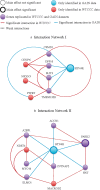A fast and powerful W-test for pairwise epistasis testing
- PMID: 27112568
- PMCID: PMC4937324
- DOI: 10.1093/nar/gkw347
A fast and powerful W-test for pairwise epistasis testing
Erratum in
-
A fast and powerful W-test for pairwise epistasis testing.Nucleic Acids Res. 2016 Dec 1;44(21):10526. doi: 10.1093/nar/gkw866. Epub 2016 Sep 26. Nucleic Acids Res. 2016. PMID: 27672040 Free PMC article. No abstract available.
Abstract
Epistasis plays an essential role in the development of complex diseases. Interaction methods face common challenge of seeking a balance between persistent power, model complexity, computation efficiency, and validity of identified bio-markers. We introduce a novel W-test to identify pairwise epistasis effect, which measures the distributional difference between cases and controls through a combined log odds ratio. The test is model-free, fast, and inherits a Chi-squared distribution with data adaptive degrees of freedom. No permutation is needed to obtain the P-values. Simulation studies demonstrated that the W-test is more powerful in low frequency variants environment than alternative methods, which are the Chi-squared test, logistic regression and multifactor-dimensionality reduction (MDR). In two independent real bipolar disorder genome-wide associations (GWAS) datasets, the W-test identified significant interactions pairs that can be replicated, including SLIT3-CENPN, SLIT3-TMEM132D, CNTNAP2-NDST4 and CNTCAP2-RTN4R The genes in the pairs play central roles in neurotransmission and synapse formation. A majority of the identified loci are undiscoverable by main effect and are low frequency variants. The proposed method offers a powerful alternative tool for mapping the genetic puzzle underlying complex disorders.
© The Author(s) 2016. Published by Oxford University Press on behalf of Nucleic Acids Research.
Figures





References
-
- Kraft P., Hunter D.J. Genetic risk prediction - are we there yet? N. Engl. J. Med. 2009;360:1701–1703. - PubMed
Publication types
MeSH terms
Grants and funding
LinkOut - more resources
Full Text Sources
Other Literature Sources

